Degradation of Styrenic Plastics during Recycling: Accommodation of PP within ABS after WEEE Plastics Imperfect Sorting
Abstract
:1. Introduction
2. Materials and Methods
2.1. Materials
2.2. Polymer Processing
2.3. Mechanical Characterization
2.4. Charpy Impact
2.5. Tensile Tests
2.6. Characterization of Morphologies
2.7. Design of Experiments
3. Results and Discussion
3.1. Impact of PP on ABS for Various Incorporation Rates
3.1.1. Impact Properties
3.1.2. Tensile Properties
3.1.3. Morphology
3.1.4. Conclusions on PP Contamination of ABS
3.2. Compatibilizers Preselection
3.2.1. Impact Properties
3.2.2. Morphology
3.2.3. Tensile Properties
3.2.4. Conclusions on Compatibilization Trials
3.3. DOE-RSM: Influence of Process Parameters and Interactions with Compatibilizers toward Impact Properties
3.3.1. Uncompatibilized System
3.3.2. PP-g-SAN
3.3.3. PP-g-MA
3.3.4. SEBS
3.3.5. Conclusions on RSM Results
4. Conclusions
Supplementary Materials
Author Contributions
Funding
Institutional Review Board Statement
Informed Consent Statement
Data Availability Statement
Acknowledgments
Conflicts of Interest
Abbreviations
| ABS: | Acrylonitrile Butadiene Styrene |
| DOE: | Design Of Experiments |
| ELV: | End-of-Life Vehicles |
| -g-MA: | Grafted with Maleic anhydride |
| RSM: | Response Surface Methodology |
| phr: | Parts per Hundred of Resin |
| PP: | Polypropylene |
| PPC: | Polypropylene copolymer |
| PPH: | Polypropylene homopolymer |
| SEBS: | Styrene-Ethylene-Butylene-Styrene |
| SEM: | Scanning Electron Microscope |
| TPE: | Thermoplastic elastomer |
| WEEE: | Waste Electrical and Electronic Equipment |
| WEEP: | WEEE plastics |
Appendix A. Highlights
- Impact properties of ABS decreases from 2 wt% PP for notched, 4 wt% for unnotched;
- Tensile properties are diminished beyond 4 wt% of PP;
- SEBS is the most promising compatibilizer improving the dissipative behavior and refining morphologies;
- DOE-RSM showed an influence of process parameters on impact properties;
- Response is different with or without compatibilizer.
References
- Geyer, R.; Jambeck, J.R.; Law, K.L. Production, use, and fate of all plastics ever made. Sci. Adv. 2017, 3, e1700782. [Google Scholar] [CrossRef] [PubMed] [Green Version]
- Robinson, B.H. E-waste: An assessment of global production and environmental impacts. Sci. Total Environ. 2009, 408, 183–191. [Google Scholar] [CrossRef]
- Bovea, M.D.; Pérez-Belis, V.; Ibáñez-Forés, V.; Quemades-Beltrán, P. Disassembly properties and material characterisation of household small waste electric and electronic equipment. Waste Manag. 2016, 53, 225–236. [Google Scholar] [CrossRef]
- Menad, N.; Björkman, B.; Allain, E.G. Combustion of plastics contained in electric and electronic scrap. Resour. Conserv. Recycl. 1998, 24, 65–85. [Google Scholar] [CrossRef]
- Stenvall, E.; Tostar, S.; Boldizar, A.; Foreman, M.R.S.; Möller, K. An analysis of the composition and metal contamination of plastics from waste electrical and electronic equipment (WEEE). Waste Manag. 2013, 33, 915–922. [Google Scholar] [CrossRef]
- Vilaplana, F.; Karlsson, S. Quality concepts for the improved use of recycled polymeric materials: A review. Macromol. Mater. Eng. 2008, 293, 274–297. [Google Scholar] [CrossRef]
- Wang, R.; Xu, Z. Recycling of non-metallic fractions from waste electrical and electronic equipment (WEEE): A review. Waste Manag. 2014, 34, 1455–1469. [Google Scholar] [CrossRef]
- Martinho, G.; Pires, A.; Saraiva, L.; Ribeiro, R. Composition of plastics from waste electrical and electronic equipment (WEEE) by direct sampling. Waste Manag. 2012, 32, 1213–1217. [Google Scholar] [CrossRef]
- Wäger, P.A.; Hischier, R. Life cycle assessment of post-consumer plastics production from waste electrical and electronic equipment (WEEE) treatment residues in a Central European plastics recycling plant. Sci. Total Environ. 2015, 529, 158–167. [Google Scholar] [CrossRef] [PubMed]
- WRAP. LCA of Management Options for Mixed Waste Plastics, Waste Resource Action Programme (WRAP); WRAP: Banbury, UK, 2008. [Google Scholar]
- Maris, J.; Bourdon, S.; Brossard, J.-M.; Cauret, L.; Fontaine, L.; Montembault, V. Mechanical recycling: Compatibilization of mixed thermoplastic wastes. Polym. Degrad. Stab. 2018, 147, 245–266. [Google Scholar] [CrossRef]
- Peeters, J.R.; Vanegas, P.; Kellens, K.; Wang, F.; Huisman, J.; Dewulf, W.; Duflou, J.R. Forecasting waste compositions: A case study on plastic waste of electronic display housings. Waste Manag. 2015, 46, 28–39. [Google Scholar] [CrossRef] [PubMed] [Green Version]
- Schlummer, M.; Gruber, L.; Mäurer, A.; Wolz, G.; van Eldik, R. Characterisation of polymer fractions from waste electrical and electronic equipment (WEEE) and implications for waste management. Chemosphere 2007, 67, 1866–1876. [Google Scholar] [CrossRef]
- Maris, E.; Botané, P.; Wavrer, P.; Froelich, D. Characterizing plastics originating from WEEE: A case study in France. Miner. Eng. 2015, 76, 28–37. [Google Scholar] [CrossRef] [Green Version]
- Beigbeder, J.; Perrin, D.; Mascaro, J.-F.; Lopez-Cuesta, J.-M. Study of the physico-chemical properties of recycled polymers from waste electrical and electronic equipment (WEEE) sorted by high resolution near infrared devices. Resour. Conserv. Recycl. 2013, 78, 105–114. [Google Scholar] [CrossRef]
- Ragaert, K.; Delva, L.; Van Geem, K. Mechanical and chemical recycling of solid plastic waste. Waste Manag. 2017, 69, 24–58. [Google Scholar] [CrossRef] [PubMed]
- Utracki, L.A. Compatibilization of Polymer Blends. Can. J. Chem. Eng. 2002, 80, 1008–1016. [Google Scholar] [CrossRef] [Green Version]
- Kassouf, A.; Maalouly, J.; Rutledge, D.N.; Chebib, H.; Ducruet, V. Rapid discrimination of plastic packaging materials using MIR spectroscopy coupled with independent components analysis (ICA). Waste Manag. 2014, 34, 2131–2138. [Google Scholar] [CrossRef] [PubMed]
- Rozenstein, O.; Puckrin, E.; Adamowski, J. Development of a new approach based on midwave infrared spectroscopy for post-consumer black plastic waste sorting in the recycling industry. Waste Manag. 2017, 68, 38–44. [Google Scholar] [CrossRef]
- Signoret, C.; Caro-Bretelle, A.-S.; Lopez-Cuesta, J.-M.; Ienny, P.; Perrin, D. MIR spectral characterization of plastic to enable discrimination in an industrial recycling context: II. Specific case of polyolefins. Waste Manag. 2019, 98, 160–172. [Google Scholar] [CrossRef] [Green Version]
- Fraunhofer-Gesellschaft, 2016. Sorting Black Plastics according to Type [WWW Document]. Available online: https://www.fraunhofer.de/en/press/research-news/2016/June/sorting-black-plastics-according-to-type.html (accessed on 28 September 2017).
- Küter, A.; Reible, S.; Geibig, T.; Nüßler, D.; Pohl, N. THz imaging for recycling of black plastics. Tech. Mess. 2018, 85, 191–201. [Google Scholar] [CrossRef]
- Barbier, S.; Perrier, S.; Freyermuth, P.; Perrin, D.; Gallard, B.; Gilon, N. Plastic identification based on molecular and elemental information from laser induced breakdown spectra: A comparison of plasma conditions in view of efficient sorting. Spectrochim. Acta Part B At. Spectrosc. 2013, 88, 167–173. [Google Scholar] [CrossRef] [Green Version]
- Roh, S.-B.; Park, S.-B.; Oh, S.-K.; Park, E.-K.; Choi, W.Z. Development of intelligent sorting system realized with the aid of laser-induced breakdown spectroscopy and hybrid preprocessing algorithm-based radial basis function neural networks for recycling black plastic wastes. J. Mater. Cycles Waste Manag. 2018, 1–16. [Google Scholar] [CrossRef]
- Wagner, F.; Peeters, J.R.; De Keyzer, J.; Janssens, K.; Duflou, J.R.; Dewulf, W. Towards a more circular economy for WEEE plastics—Part B: Assessment of the technical feasibility of recycling strategies. Waste Manag. 2019, 96, 206–214. [Google Scholar] [CrossRef] [PubMed]
- Perrin, D.; Mantaux, O.; Ienny, P.; Léger, R.; Dumon, M.; Lopez-Cuesta, J.M. Influence of impurities on the performances of HIPS recycled from Waste Electric and Electronic Equipment (WEEE). Waste Manag. 2016, 56, 438–445. [Google Scholar] [CrossRef] [PubMed] [Green Version]
- Brennan, L.B.; Isaac, D.H.; Arnold, J.C. Recycling of acrylonitrile-butadiene-styrene and high-impact polystyrene from waste computer equipment. J. Appl. Polym. Sci. 2002, 86, 572–578. [Google Scholar] [CrossRef]
- De Souza, A.M.C.; Cucchiara, M.G.; Ereio, A.V. ABS/HIPS blends obtained from WEEE: Influence of processing conditions and composition. J. Appl. Polym. Sci. 2016, 133, 1–7. [Google Scholar] [CrossRef]
- Vazquez, Y.V.; Barbosa, S.E. Compatibilization Strategies for Recycling Applications of High Impact Polystyrene/Acrylonitrile Butadiene Blends. J. Polym. Environ. 2017, 25, 903–912. [Google Scholar] [CrossRef]
- Signoret, C.; Edo, M.; Lafon, D.; Caro-Bretelle, A.-S.; Lopez-Cuesta, J.-M.; Ienny, P.; Perrin, D. Degradation of styrenic plastics during recycling: Impact of reprocessing photodegraded material on aspect and mechanical properties. J. Polym. Environ. 2020, 28, 2055–2077. [Google Scholar] [CrossRef]
- Bucknall, C.B.; Cote, F.F.P.; Partridge, I.K. Rubber toughening of plastics—Part 9 Effects of rubber particle volume fraction on deformation and fracture in HIPS. J. Mater. Sci. 1986, 21, 301–306. [Google Scholar] [CrossRef]
- Hall, R.A. Computer modelling of rubber-toughened plastics: Random placement of monosized core-shell particles in a polymer matrix and interparticle distance calculations. J. Mater. Sci. 1991, 26, 5631–5636. [Google Scholar] [CrossRef]
- Han, Y.; Lach, R.; Grellmann, W. The Charpy impact fracture behaviour in ABS materials. Die Angew. Makromol. Chemie 1999, 270, 13–21. [Google Scholar] [CrossRef]
- Yokouchi, M.; Seto, S.; Kobayashi, Y. Comparison of polystyrene, poly(styrene/acrylonitrile), high-impact polystryrene, and poly(acrylonitrile/butadiene/styrene) with respect to tensile and impact properties. J. Appl. Polym. Sci. 1983, 28, 2209–2216. [Google Scholar] [CrossRef]
- Ramírez-Vargas, E.; Margarita Huerta-Martínez, B.; Javier Medellín-Rodríguez, F.; Sánchez-Valdes, S. Effect of heterophasic or random PP copolymer on the compatibility mechanism between EVA and PP copolymers. J. Appl. Polym. Sci. 2009, 112, 2290–2297. [Google Scholar] [CrossRef]
- Roumeli, E.; Markoulis, A.; Chrissafis, K.; Avgeropoulos, A.; Bikiaris, D. Substantial enhancement of PP random copolymer’s thermal stability due to the addition of MWCNTs and nanodiamonds: Decomposition kinetics and mechanism study. J. Anal. Appl. Pyrolysis 2014, 106, 71–80. [Google Scholar] [CrossRef]
- Bouvard, J.L.; Denton, B.; Freire, L.; Horstemeyer, M.F. Modeling the mechanical behavior and impact properties of polypropylene and copolymer polypropylene. J. Polym. Res. 2016, 23, 70. [Google Scholar] [CrossRef]
- Koning, C.; Duin, M.; van Pagnouille, C.; Jerome, R. Strategies for compatibilization of polymer blends. Prog. Polym. Sci. 1998, 23, 707–757. [Google Scholar] [CrossRef]
- Sundararaj, U.; Macosko, C.W. Drop Breakup and Coalescence in Polymer Blends: The Effects of Concentration and Compatibilization. Macromolecules 1995, 28, 2647–2657. [Google Scholar] [CrossRef]
- Bonda, S.; Mohanty, S.; Nayak, S.K. Influence of compatibilizer on mechanical, morphological and rheological properties of PP/ABS blends. Iran. Polym. J. 2014, 23, 415–425. [Google Scholar] [CrossRef]
- Deng, Y.; Mao, X.; Lin, J.; Chen, Q. Compatibilization of polypropylene/Poly(acrylonitrile-butadiene-styrene) blends by polypropylene-graft-cardanol. J. Appl. Polym. Sci. 2015, 132. [Google Scholar] [CrossRef]
- Ibrahim, M.A.H.; Hassan, A.; Wahit, M.U.; Hasan, M.; Mokhtar, M. Mechanical properties and morphology of polypropylene/poly(acrylonitrile–butadiene–styrene) nanocomposites. J. Elastomers Plast. 2017, 49, 209–225. [Google Scholar] [CrossRef]
- Kum, C.K.; Sung, Y.-T.; Kim, Y.S.; Lee, H.G.; Kim, W.N.; Lee, H.S.; Yoon, H.G. Effects of compatibilizer on mechanical, morphological, and rheological properties of polypropylene/poly(acrylonitrile-butadiene-styrene) blends. Macromol. Res. 2007, 15, 308–314. [Google Scholar] [CrossRef]
- Lee, Y.K.; Lee, J.B.; Park, D.H.; Kim, W.N. Effects of accelerated aging and compatibilizers on the mechanical and morphological properties of polypropylene and poly(acrylonitrile-butadiene-styrene) blends. J. Appl. Polym. Sci. 2013, 127, 1032–1037. [Google Scholar] [CrossRef]
- Luo, Z.; Lu, Q.; Ma, F.; Jiang, Y. The effect of graft copolymers of maleic anhydride and epoxy resin on the mechanical properties and morphology of PP/ABS blends. J. Appl. Polym. Sci. 2014, 131. [Google Scholar] [CrossRef]
- Patel, A.C.; Brahmbhatt, R.B.; Sarawade, B.D.; Devi, S. Morphological and mechanical properties of PP/ABS blends compatibilized with PP-g-acrylic acid. J. Appl. Polym. Sci. 2001, 81, 1731–1741. [Google Scholar] [CrossRef]
- Tostar, S.; Stenvall, E.; Foreman, M.; Boldizar, A. The Influence of Compatibilizer Addition and Gamma Irradiation on Mechanical and Rheological Properties of a Recycled WEEE Plastics Blend. Recycling 2016, 1, 101. [Google Scholar] [CrossRef] [Green Version]
- Plochocki, A.P.; Dagli, S.S.; Andrews, R.D. The interface in binary mixtures of polymers containing a corresponding block copolymer: Effects of industrial mixing processes and of coalescence. Polym. Eng. Sci. 1990, 30, 741–752. [Google Scholar] [CrossRef]
- Favis, B.D.; Chalifoux, J.P. The effect of viscosity ratio on the morphology of polypropylene/polycarbonate blends during processing. Polym. Eng. Sci. 1987, 27, 1591–1600. [Google Scholar] [CrossRef]
- Landrein, P.; Lorriot, T.; Guillaumat, L. Influence of some test parameters on specimen loading determination methods in instrumented Charpy impact tests. Eng. Fract. Mech. 2001, 68, 1631–1645. [Google Scholar] [CrossRef]
- Fellahi, S.; Favis, B.D.; Fisa, B. Morphological stability in injection-moulded high-density polyethylene/polyamide-6 blends. Polymer 1996, 37, 2615–2626. [Google Scholar] [CrossRef]
- Karger-Kocsis, J.; Csikai, I. Skin-Core morphology and failure of injection-molded specimens of impact-modified polypropylene blends. Polym. Eng. Sci. 1987, 27, 241–253. [Google Scholar] [CrossRef]
- Li, Z.-M.; Yang, W.; Yang, S.; Huang, R.; Yang, M.-B. Morphology-tensile behavior relationship in injection molded poly(ethylene terephthalate)/polyethylene and polycarbonate/polyethylene blends (I) Part I Skin-core Structure. J. Mater. Sci. 2004, 39, 413–431. [Google Scholar] [CrossRef]
- Li, Z.-M.; Xie, B.-H.; Yang, S.; Huang, R.; Yang, M.-B. Morphology-tensile behavior relationship in injection molded poly(ethylene terephthalate)/polyethylene and polycarbonate/polyethylene blends (II) Part II Tensile behavior. J. Mater. Sci. 2004, 39, 433–443. [Google Scholar] [CrossRef]
- Li, Z.M.; Qian, Z.Q.; Yang, M.B.; Yang, W.; Xie, B.H.; Huang, R. Anisotropic microstructure-impact fracture behavior relationship of polycarbonate/polyethylene blends injection-molded at different temperatures. Polymer 2005, 46, 10466–10477. [Google Scholar] [CrossRef]
- Charoen, N.; Leong, Y.W.; Hamada, H. Determination of different morphological structures in PC/ABS open spiral injection moldings. Polym. Eng. Sci. 2008, 48, 786–794. [Google Scholar] [CrossRef]
- Zhong, G.-J.; Li, Z.-M. Injection molding-induced morphology of thermoplastic polymer blends. Polym. Eng. Sci. 2005, 45, 1655–1665. [Google Scholar] [CrossRef]
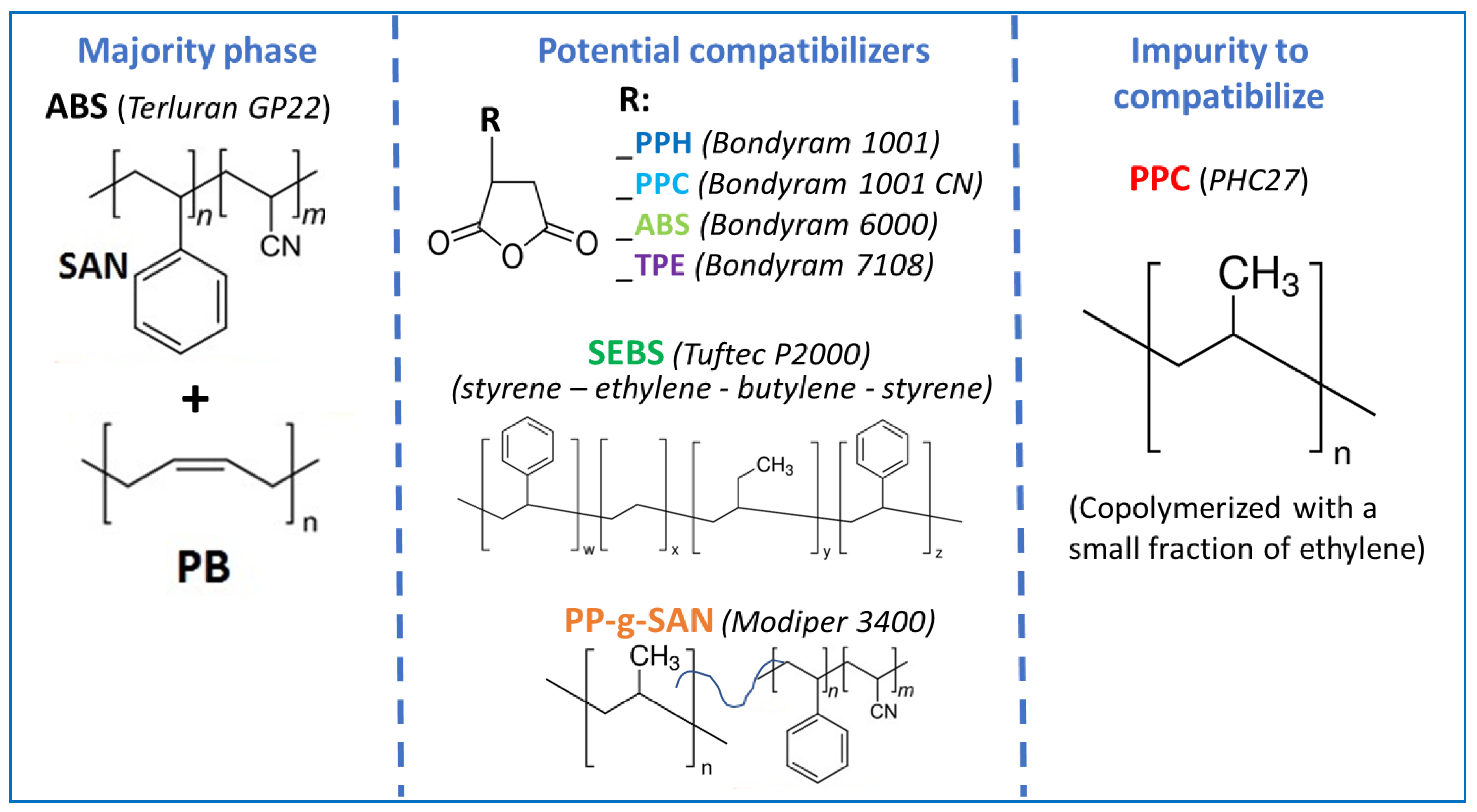
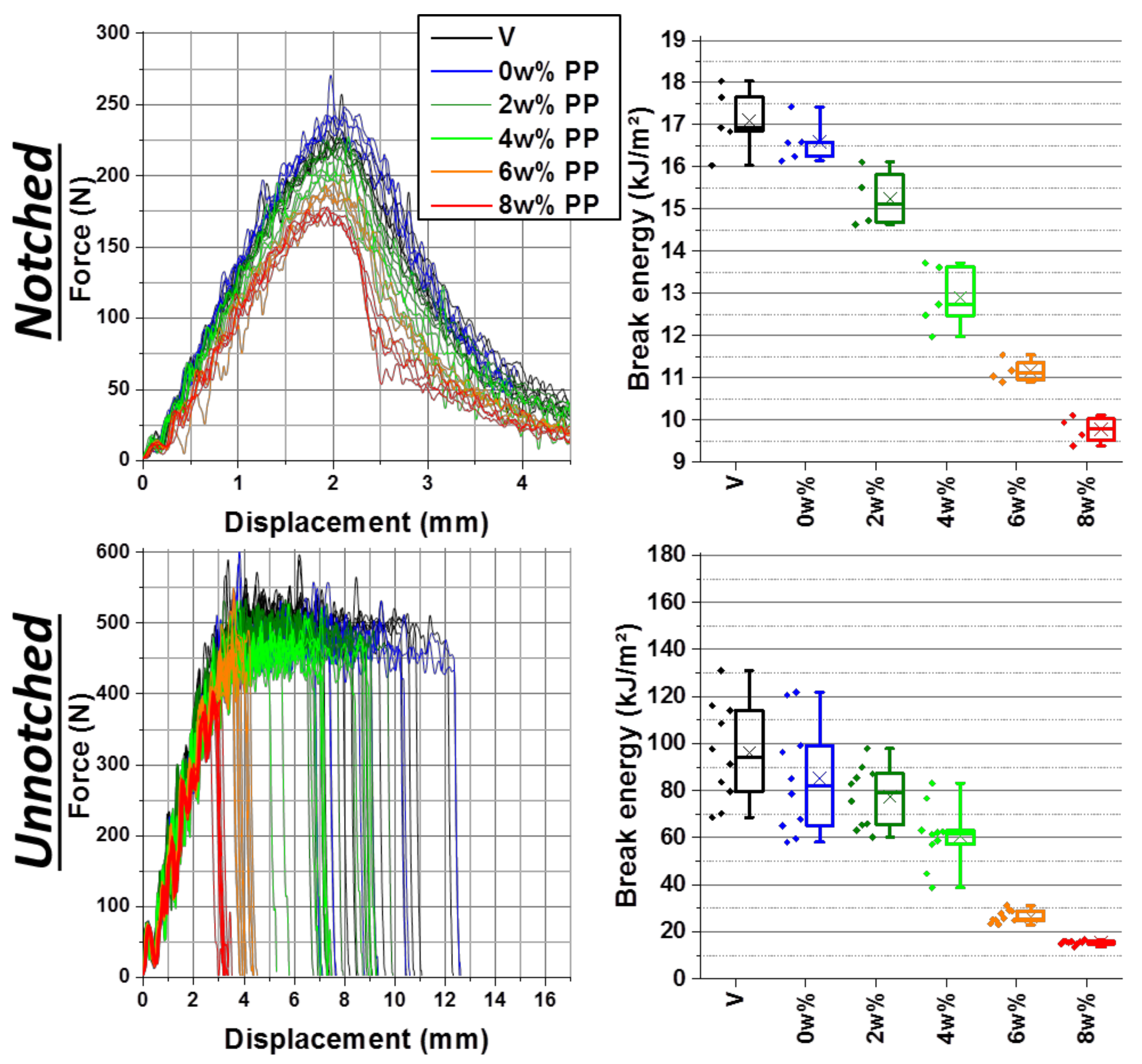




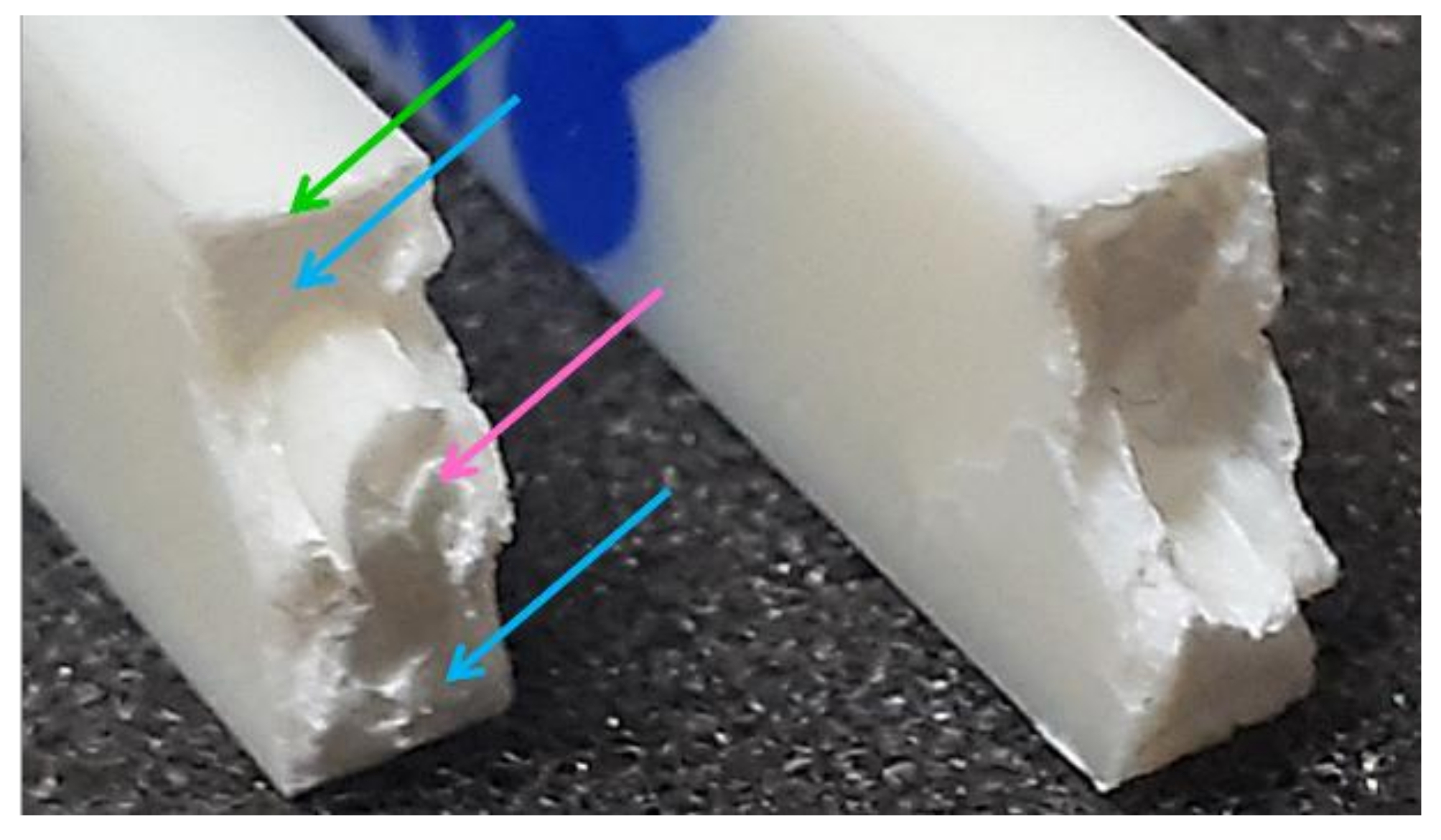
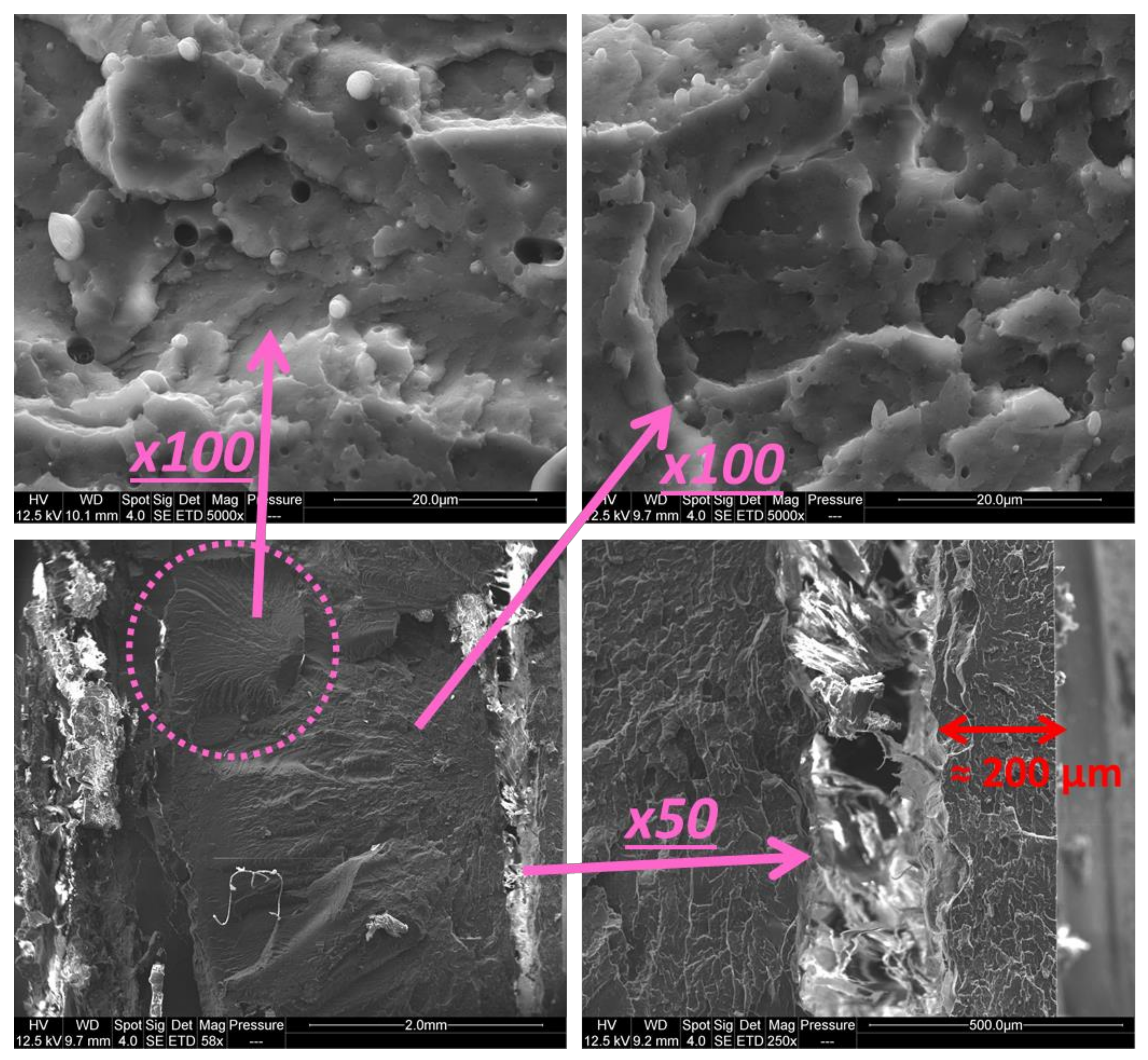

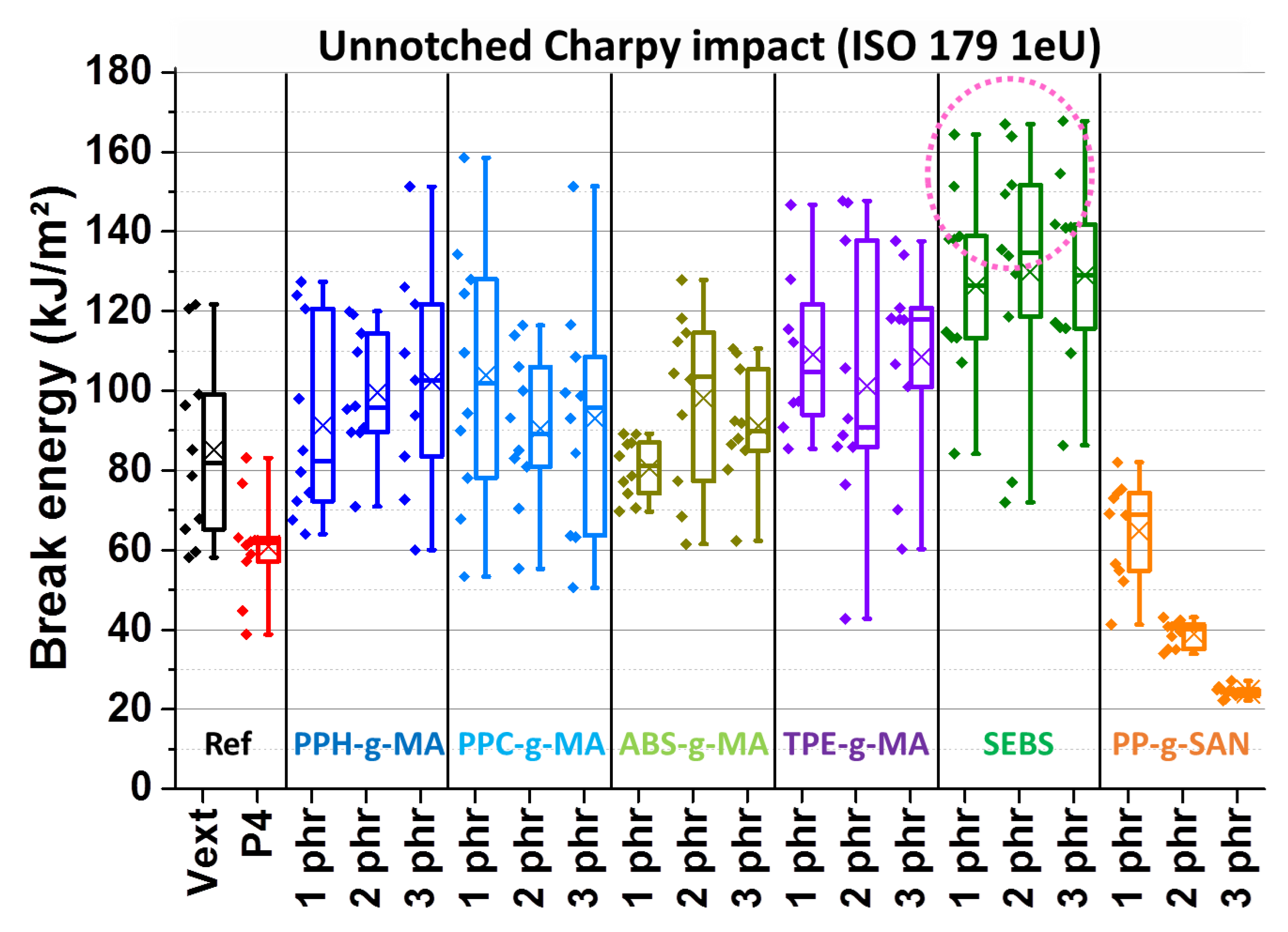
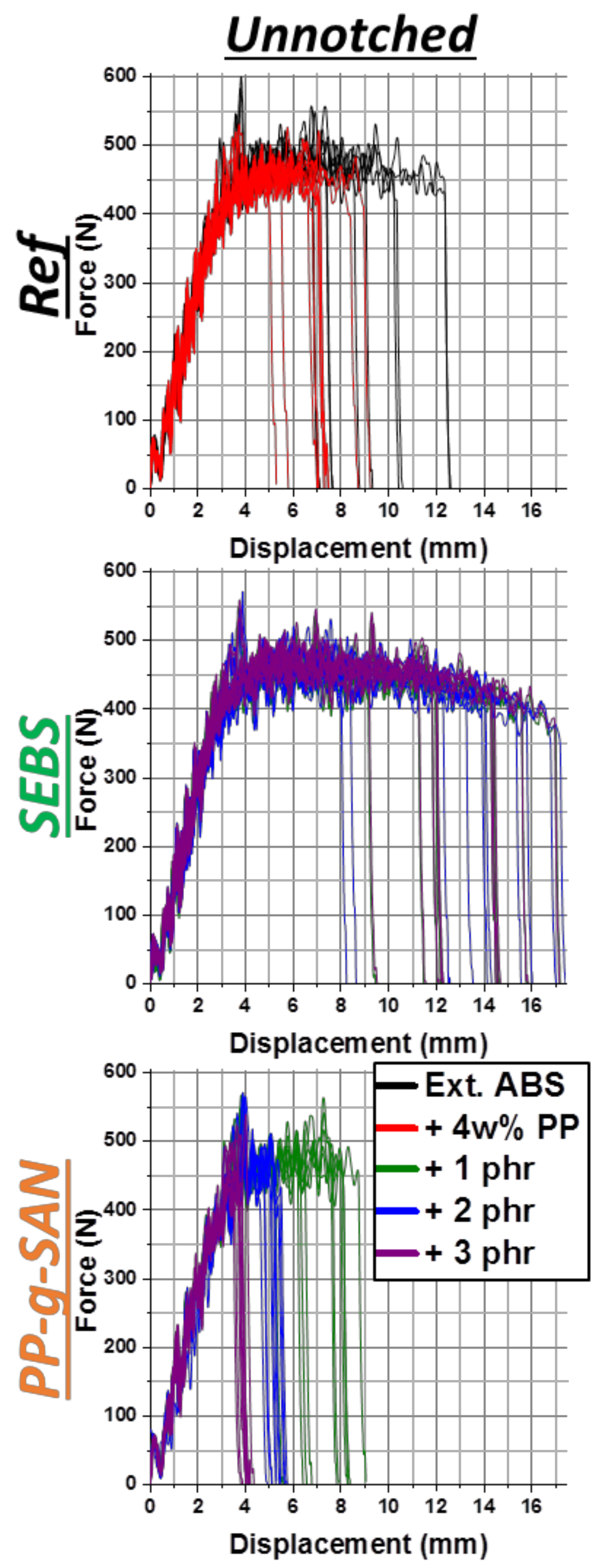
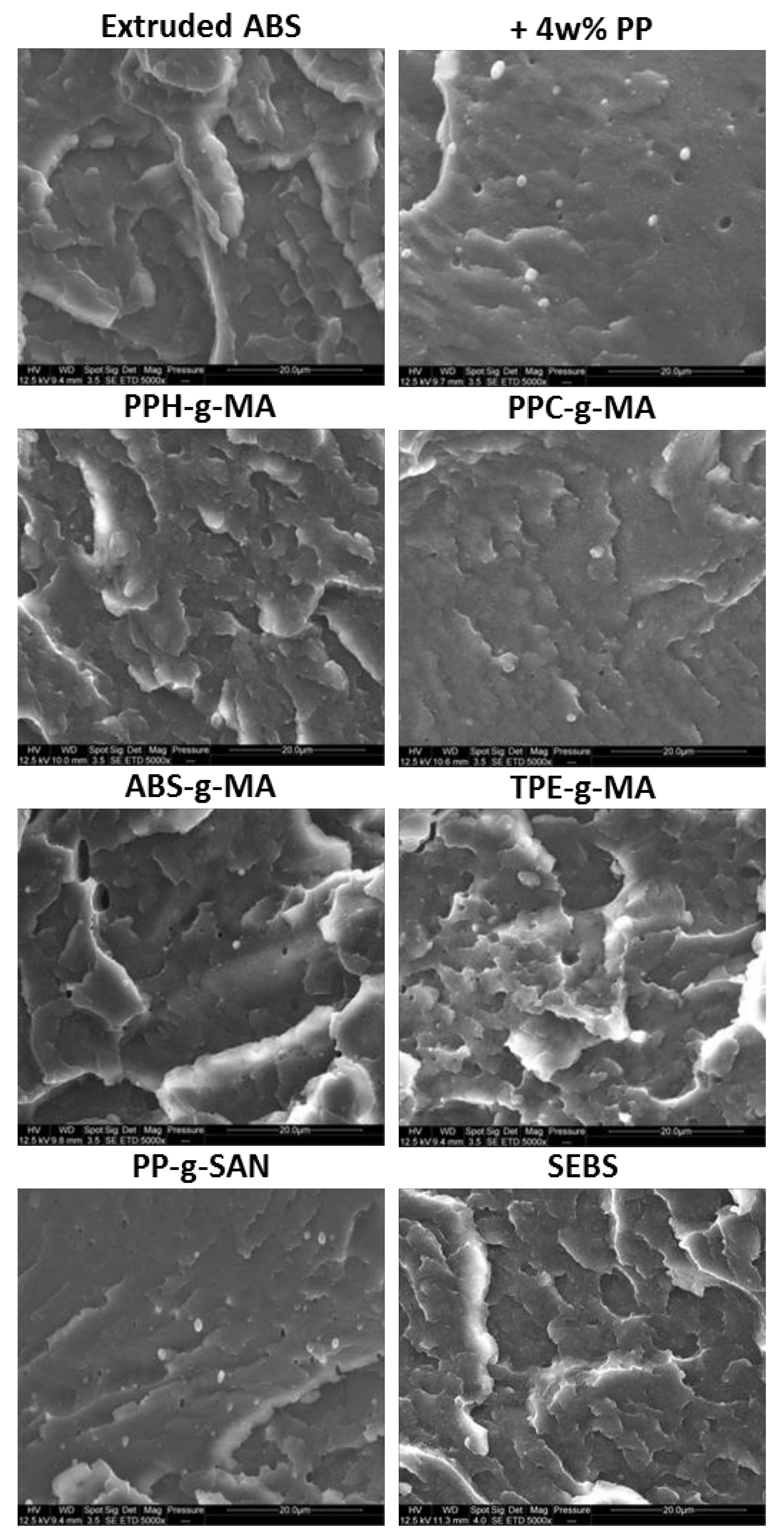



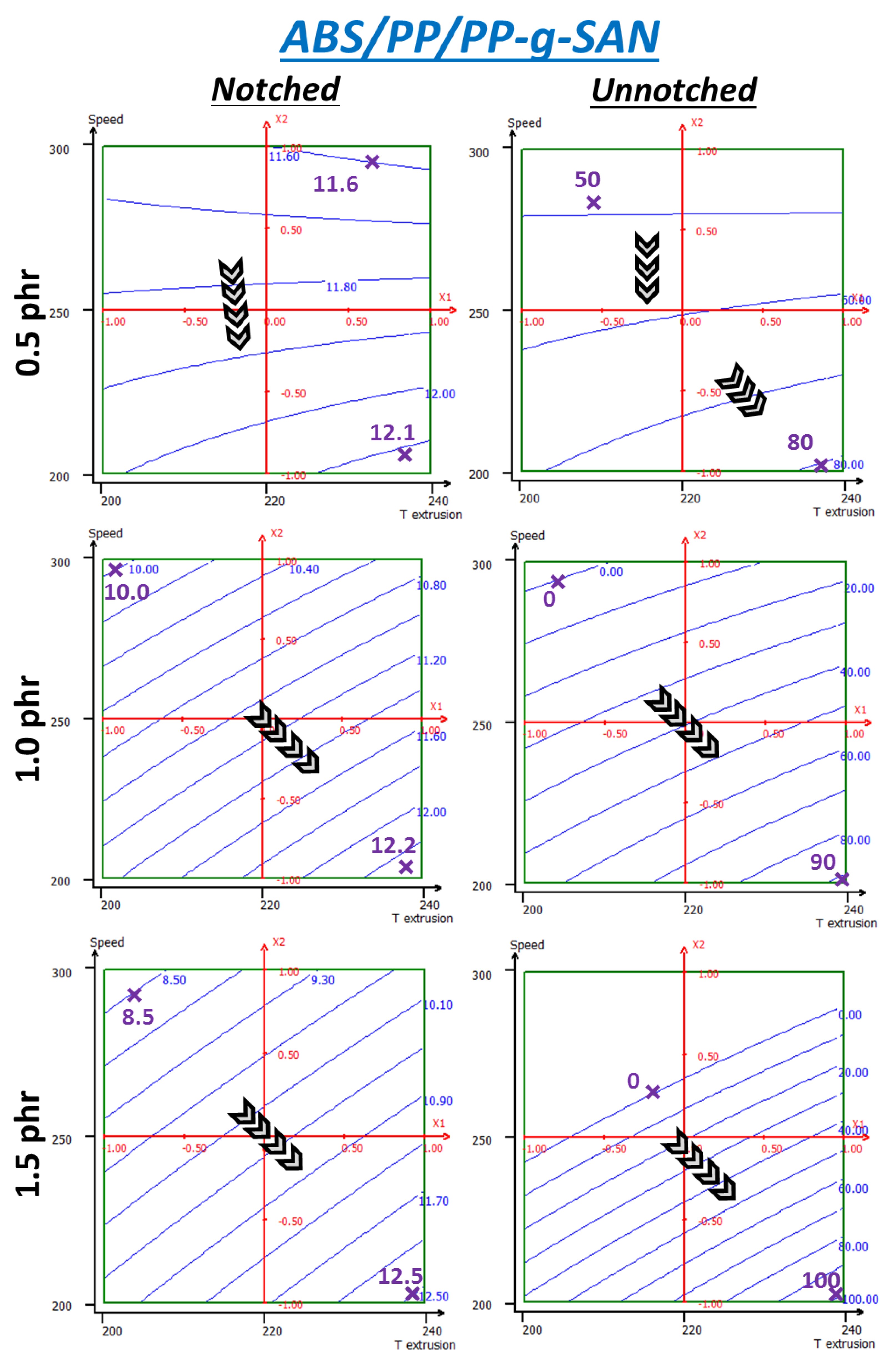

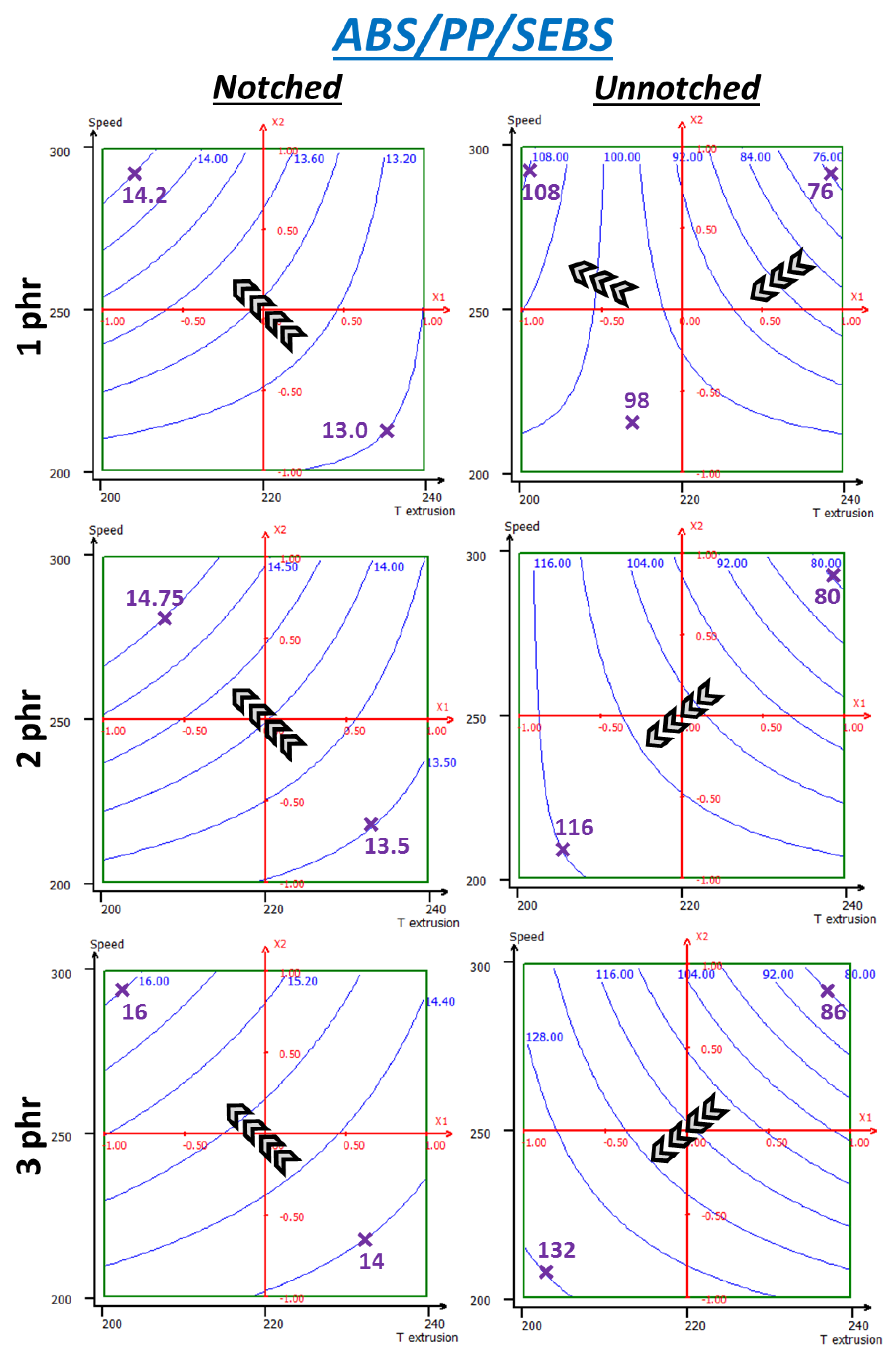
Publisher’s Note: MDPI stays neutral with regard to jurisdictional claims in published maps and institutional affiliations. |
© 2021 by the authors. Licensee MDPI, Basel, Switzerland. This article is an open access article distributed under the terms and conditions of the Creative Commons Attribution (CC BY) license (https://creativecommons.org/licenses/by/4.0/).
Share and Cite
Signoret, C.; Girard, P.; Guen, A.L.; Caro-Bretelle, A.-S.; Lopez-Cuesta, J.-M.; Ienny, P.; Perrin, D. Degradation of Styrenic Plastics during Recycling: Accommodation of PP within ABS after WEEE Plastics Imperfect Sorting. Polymers 2021, 13, 1439. https://doi.org/10.3390/polym13091439
Signoret C, Girard P, Guen AL, Caro-Bretelle A-S, Lopez-Cuesta J-M, Ienny P, Perrin D. Degradation of Styrenic Plastics during Recycling: Accommodation of PP within ABS after WEEE Plastics Imperfect Sorting. Polymers. 2021; 13(9):1439. https://doi.org/10.3390/polym13091439
Chicago/Turabian StyleSignoret, Charles, Pierre Girard, Agathe Le Guen, Anne-Sophie Caro-Bretelle, José-Marie Lopez-Cuesta, Patrick Ienny, and Didier Perrin. 2021. "Degradation of Styrenic Plastics during Recycling: Accommodation of PP within ABS after WEEE Plastics Imperfect Sorting" Polymers 13, no. 9: 1439. https://doi.org/10.3390/polym13091439





